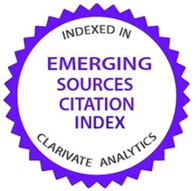La mortalidad del COVID-19 como prueba factual para fortalecer las estrategias de seguridad y defensa
DOI:
https://doi.org/10.21830/19006586.696Palabras clave:
catátrofes y seguridad, COVID-19, defensa, mortalidad, pandemias, seguridadResumen
La pandemia del COVID-19 ha generado grandes cambios políticos, económicos y sociales, por lo cual, en consecuencia, las estrategias de seguridad y defensa han enfrentado una amenaza inusual, que puede poner en riesgo soberanías, territorios y alterar el orden mundial. Esta investigación, realizada con un estudio tipo mixto con enfoque histórico, estadístico y epidemiológico observacional no experimental simulado, utiliza cinco variables independientes y una dependiente con el objetivo de comparar la mortalidad de las guerras y el terrorismo trasnacional con la de la actual pandemia, y así mismo proyectar el impacto de una eventual pandemia futura sobre dichas estrategias. Mediante esto se busca establecer una prueba factual, con sólidos argumentos, que explique la necesidad de fortalecer y replantear las estrategias de seguridad y defensa para el futuro pos-COVID.
Descargas
Referencias bibliográficas
Appel, C., Hasell, J., Ritchie, H., & Roser, M. (2019). Our world in data. https://ourworldindata.org/
Ardila, C., & Jiménez, J. (2018). Convergencia de conceptos: enfoques sinérgicos en relación a las amenazas a la seguridad del Estado colombiano. Escuela Superior de Guerra “General Rafael Reyes Prieto”; Centro de Estudios Estratégicos en Seguridad y Defensa Nacionales. https://doi.org/10.25062/9789585698307
Atran, S., Fischhoff, B., & Fischhoff, N. (2007). Counting casualties: A framework for respectful, useful records. Journal of Risk and Uncertainty, 34, 1-19. https://doi.org/10.1007/s11166-006-9001-6
Baldwin, D. (1997). The concept of security. Review of International Studies, 23, 5-26. https://www.jstor.org/stable/20097464?seq=1
Baroni, S., & Tarlebbea, N. (2010). The Cameroon and Nigeria negotiation. Process over the contested oil rich Bakassi peninsula. Journal of Alternative Perspectives in the Social Sciences, 2(1), 198-210.
Bennett, C., Braeger, C., Duplat, M., Geling, A., Glorion, J., Grégoire, M., Heinrichs, P., Hogenboom, J., Kim, G., Pathak, J., Pernot, L., Stenberg, R., Tzatzev, A., Voelker, L., & Wei, H. (2015). Mapping controversies. Counting the dead (T. Tari, supervision) (paper). SciencesPo. Paris School of International Affairs, 72. https://bit.ly/30FRzQ7
Berman, F. (2020, 10 de agosto). Cyberspace is critical infrastructure – It will take effective government oversight to make it safe. The Conversation. https://bit.ly/3lqdN2p
Bijak, J., & Tabeau, E. (2005). War-related deaths in the 1992-1995 armed conflicts in Bosnia and Herzegovina: A critique of previous estimates and recent results. European Journal of Population / Revue Européenne de Démographie, 21(2-3), 187-215. https://doi.org/10.1007/s10680-005-6852-5
Bonilla, A. (Ed.). (1999). Ecuador-Perú. Horizontes de la negociación y el conflicto. Flacso; Desco. https://biblio.flacsoandes.edu.ec/catalog/resGet.php?resId=50982
Borrell, J. (2020, 14 de mayo). European defence: fighting COVID-19, preparing for the future. European Union, External Action Service (EEAS). https://bit.ly/3vqLXaP
Cardona, I., Baettig, S., Parini, A., & Morand, G. (2020). Case series of coronavirus (SARS-CoV-2) in a military recruit school: Clinical, sanitary and logistical implications. BMJ Military Health. https://doi.org/10.1136/bmjmilitary-2020-001482
Carlson, J. (2013). A war by any other name… reduces the size of your “N” by 20%: Case selection and the correlates of war (COW) inter-state war data set (APSA 2013 Annual Meeting Paper). School of Social Sciences, Humanities & Arts. https://papers.ssrn.com/sol3/papers.cfm?abstract_id=2301483
Cebecí, M. (2004). Multidimensional security concept and its implications for post-coldwar Europe and Turkey (tesis doctoral, Marmara University, Estambul). https://bit.ly/2OULoF6
Centers for Disease Control and Prevention (CDC). (2012). Principles of epidemiology in public health practice (3rd ed.). https://www.cdc.gov/csels/dsepd/ss1978/SS1978.pdf
Centre d’Études Stratégiques de l’Afrique. (2019, 26 de julio). Centre d’Études Stratégiques de l’Afrique [sitio web]. https://africacenter.org/fr/
Clingendael. Netherlands Institute of International Relations. (2020, abril). Defense and Covid-19: Why budget cuts should be off the table (Clingendael Alert). https://bit.ly/3bLLXKt
Congressional Research Service. (2020, 30 de abril). COVID-19: National security and defense strategy (CRS Report). https://crsreports.congress.gov/product/pdf/IF/IF11525
Cook, N. (1998). Born to die: Disease and new world conquest, 1492-1650 (Vol. 1). Cambridge University Press.
Daponte, B. (1993). A case study in estimating casualties from war and its aftermath: The 1991 Persian Gulf war. PSR Quarterly, 3(2), 57-66. https://catalog.ihsn.org/index.php/citations/57375
Defence and Security Commitee. (2020). The role of NATO’S Armed Forces in the COVID-19 pandemic. NATO Parlament Assembly.
Defence Science Library. (2020). Newspapers Clippings, 45(88). https://bit.ly/3cv2LEX
Department of the Navy. (2020, 27 de mayo). Report of the Command investigation concerning chain of command actions with regard to COVID-19 onboard USS Theodore Roosevelt (CVN 71). https://bit.ly/3thlOJn
Dhama, K., Khan, S., Tiwari, R., Sircar, S., Bhat, S., Malik, Y., Singh, K., Chaicumpa, W., Bonilla-Aldana, D., & Rodriguez-Morales, A. (2020). Coronavirus Disease 2019–COVID-19. Clinical Microbiology Reviews, 33(4), 1-48. https://doi.org/10.1128/CMR.00028-20
Eccleston-Turner, M., & Brassington, I. (Eds.). (2020). Infectious deseases in the new millenium: Legal and ethical challenges (International Library of Ethics, Law and the New Medicine, 82). Springer Nature Switzerland AG. https://doi.org/10.1007/978-3-030-39819-4
Eriksson, M., Sollenberg, M., & Wallensteen, P. (2003). Armed conflict 1989-2002. Journal of Peace Research, 40(5), 593-607. https://doi.org/10.1177/00223433030405006
European Asylum Support Office (EASO). (2019). Syria. Security situation (Country of Origin Information Report). https://doi.org/10.2847/267982
European Parliament. (2020). Committee on Foreign Affairs. Amendments 1-351. https://bit.ly/3tmsHcm
Fernández-Osorio, A., & Ramírez, L. (2020). Editorial. Desafíos políticos, sociales y económicos para la seguridad y defensa nacionales. Revista Científica General José María Córdova, 18(30), 267-268. http://dx.doi.org/10.21830/19006586.601
Fidler, D. (2020). Editorial. Vaccine nationalism’s politics. Science, 369(6505). https://doi.org/10.1126/science.abe2275
Fisk, R. (2005). The great war for civilisation. The conquest of Middle East. Vintage Books. https://libcom.org/files/The_Great_War_for_Civilisation.pdf
Font, T. & Ortega P. (2012). Seguridad nacional, seguridad multidimensional, seguridad humana. Papeles de Relaciones Ecosociales y Cambio Global, 11, 161-172. https://bit.ly/2OuUXLi
Fuentes, P. (1992). Las grandes epidemias en la temprana Edad Media y su proyección sobre la Península Ibérica. En la España Medieval, 15, 9-29. https://bit.ly/30I8ilY
Garay, C., & Santana, M. (2019). Efectos de las amenazas transnacionales en los derechos humanos. En C. Ardila, & J. Jiménez (Eds.), Convergencia de conceptos: enfoques sinérgicos en relación a las amenazas a la seguridad del Estado colombiano (pp. 173-206). Escuela Superior de Guerra. https://doi.org/10.25062/9789585698307.06
García, D. (2019). Hacia un nuevo concepto de seguridad en un espacio multidominio: complejidad, guerra y seguridad transdominio (Documento de Opinión 85). Instituto Español de Estudios Estratégicos (IEEE). https://bit.ly/3bNQ5tI
Gaub, F. (2017). Trends in terrorism (Issue Alert 4). European Union Institute for Security Studies (EUISS). https://doi.org/10.2815/66788
Geun-Pyeong, L. (Ed.). (2020, 2 de febrero). An emergency caught by an infected person in contact with the unit... [título original en coreano]. https://news.joins.com/article/23716158
Gordon, N. (2012). The application of database technologies to the study of terrorism and counter-terrorism: A post 9/11 analysis (tesis doctoral, School of International Relations, University of St Andrews). https://core.ac.uk/reader/13120382
Haines, A., & Lee, I. (1991). Health costs of the Gulf war. British Medical Journal, 303, 4. https://doi.org/10.1136/bmj.303.6797.303
Hernández, R., Fernández, C., & Baptista, P. (2006). Metodología de la investigación (4.ª ed.). (R. Del bosque, Ed.). Mc Graw-Hill Interamericana
Herrán, O., Martínez, A., & Ospina, J. (2009). Impacto de la pandemia de gripa de 1918-1919 sobre el perfil de mortalidad general en Boyacá, Colombia. História, Ciências, Saúde-Manguinhos, 16(1), 53-81. http://dx.doi.org/10.1590/S0104-59702009000100004
Houston, A. (2020). Applying lessons from the past in Haiti: Cholera, Scientific knowledge, and the longest-standing principle of international health law. En M. Eccleston & I. Brassington (Eds.), Infectious deseases in the new millenium: Legal and ethical challenges (International Library of Ethics, Law and the New Medicine, 82). Springer Nature Switzerland AG. https://doi.org/10.1007/978-3-030-39819-4
Hughes, C. (2006). A multidimensional approach to security: The case of Japan (Working paper 2006-15). Centre for the Study of Globalisation and Regionalisation, University of Warwick, UK. https://www.files.ethz.ch/isn/21877/Hughes.pdf
Hurt, M. (2020, abril). The impact of COVID-19 on military exercises in Europe. International Centre for Defence and Security (ICDS). https://bit.ly/2OpoFS2
Institute for Economics & Peace. (2019). Global Terrorism Index 2019: Measuring the impact of terrorism.
International Crisis Group. (2001, 21 de diciembre). Rwanda/Uganda: A dangerous war of nerves (ICG Africa Briefing). https://bit.ly/2OTubw5
Johnston, R. (2018). Selected terrorist attacks and related incidents worldwide (Part I, II, II and IV). http://www.johnstonsarchive.net/terrorism/wrjp255b.html
Klarevas, L. (2011). Trends in terrorism Since 9/11: Is terrorism still a threat to the United States? Georgetown Journal of International Affairs, 12(1), 76-88. www.jstor.org/stable/43133867
Krasner, S. (2014). A grand strategy essay: Transnational terrorism. Working Group on Foreign Policy and Grand Strategy; Hoover Institution; Stanford University. https://hvr.co/3lf2wBE
Laborde, D., Martin, W., Swinnen, J., & Vos, R. (2020). COVID-19 risks to global food security. Science, 369(6503), 500-502. https://doi.org/10.1126/science.abc4765
Lacina, B., & Gleditsch, N. (2005). Monitoring trends in global combat: A new dataset of battle death. European Journal of Population, 21, 145-166. https://doi.org/10.1007/s10680-005-6851-6
Leitenberg, M. (2006). Death in wars and conflicts in the 20th century (Occasional Paper 29, 3th ed.) Peace Studies Program, Cornell University. https://bit.ly/3eCvnyx
Lwoff, A. (1957). The concept of virus. The third Marjory Stephenson Memorial Lecture. Journal of General Microbiology, 17(1), 239-253. https://bit.ly/3cuDdrh
Lyons, T. (2009). The Ethiopia-Eritrea conflict and the search for peace in the horn of Africa. Review of African Political Economy, 36(120), 167-180. http://dx.doi.org/10.1080/03056240903068053
Martínez, J. (2019). Las fuerzas aéreas aliadas ante los futuros escenarios multidominio. Revista de Aeronáutica y Astronáutica, 881, 158-172. https://bit.ly/3cuHVp8
Millen, R. & PKSOI Team (2020, 18 de agosto). Establishing security during pandemics. Peacekeeping and Stability Operations Institute. https://bit.ly/3vlHENL
Moghadam, S. (2020, 24 de julio). A review on currently available potential therapeutic options for COVID-19. International Journal of General Medicine, 13, 443-467. https://doi.org/10.2147/IJGM.S263666
National Commission on Terrorist Attacks. (2005). The 9/11 Commission Report. https://www.9-11commis-sion.gov/report/911Report.pdf
National Consortium Study of Terrorism and Responses to Terrorism (Start). (2016). Global Terrorism Index 2016. Institute for Economics & Peace. https://reliefweb.int/report/world/global-terrorism-index-2016
National Consortium Study of Terrorism and Responses to Terrorism (Start). (2018, septiembre). Statistical information on terrorism 2017. https://bit.ly/3vrmBcT
National Consortium Study of Terrorism and Responses to Terrorism (Start). (2019). Global Terrorism Database. Information on more than 200,000 terrorist attacks [base de datos]. https://www.start.umd.edu/gtd/
National Counterterrorism Center (NCTC). (2012). 2011 Report on Terrorism. https://www.hsdl.org/?view&did=712017
Öberg, M., & Pettersson, T. (2020). UCDP Battle-related deaths dataset codebook, version 20.1. Organized violence, 1989-2019 [archivos de base de datos]. https://ucdp.uu.se/downloads/index.html#battlerelated
Office of the Secretary of State. (1993, 30 de abril). Patterns of Global Terrorism: 1992. https://fas.org/irp/threat/terror_92/index.html
Okoi, O. (2016). Why nations fight: The causes of the Nigeria–Cameroon Bakassi Peninsula conflict. African Security, 9(1), 42-65. http://dx.doi.org/10.1080/19392206.2016.1132904
Organización de las Naciones Unidas (ONU). (2020, abril). Marco de la ONU para la respuesta socioeconómica inmediata ante el COVID-19. https://bit.ly/3bLAH0C
Organización Mundial de la Salud (OMS). (2007, junio). Infection prevention and control of epidemic and pandemic-prone acute respiratory diseases in health care (WHO Interim Guidelines). https://bit.ly/2Q4M6jZ
Organización Mundial de la Salud (OMS). (2020a, 16 de julio). Coronavirus disease (COVID-19). Situation report – 178. https://bit.ly/2OwywFx
Organización Mundial de la Salud (OMS). (2020b, 23 de abril). Coronavirus disease (COVID-19). Situation report – 94. https://bit.ly/3rRdHTy
Organización Mundial de la Salud (OMS). (s. f.). WHO Coronavirus disease (COVID-19). Dashboard. Consultado en septiembre de 2020. https://bit.ly/38EZqSv
Organización Panamericana de la Salud (OPS). (2003). Epidemiología básica (2.ª ed.) (R. Beaglehole, R. Bonita, & T. Kjellstrõm, Eds.).
Pérez, B. (2013). Multidimensional security, “Ungoverned Areas”and Non-State Actors (Occasional paper 9). Calgary Papers in Military and Strategic Studies. https://bit.ly/3lkjqij
Pertago, R. (2012). Editorial: Human security and public health. Pan American Journal of Public, 31(5), 355-358. https://scielosp.org/pdf/rpsp/2012.v31n5/351-358/en
Pettersson, T., & Wallensteen, P. (2015). Armed conflicts, 1946-2014. Journal of Peace Research, 52(4), 536- 550. https://doi.org/10.1177/0022343315595927
Project Ploughshares. (2002). Armed conflicts report: Ethiopia-Eritrea. https://ploughshares.ca/pl_armed-conflict/ethiopiaeritrea-1998-2001/
Pudsey, A. (2017). Disability in antiquity: Rewriting antiquity (C. Laes, Ed.). Routledge. https://doi. org/10.4324/9781315625287
Radiation Effects Research Foundation (RERF). (1947). Atomic Bomb Casualty Commission General Report 1947. https://bit.ly/3bJX8Dp
RAND Corporation & MIPT. (2006). RAND Terrorism Chronology Database and RAND-MIPT Terrorism Incident Database [base de datos]. http://www.rand.org/ise/projects/terrorismdatabase/
RAND Corporation. (2009). RAND Database of Worldwide Terrorism Incidents, 1968-2009. http:// www.rand.org/nsrd/projects/terrorism-incidents.html
Rapoport, D. (2013). The four waves of modern terror: International dimensions and consequences. En J. Hanhimäki & B. Blumenau (Eds.), An international history of terrorism: Western and Non-Western experiences (pp. 282-310). Routledge. https://doi.org/10.4324/9780203093467
Reuters. (2020, 6 de abril). U.S. Forces Japan declares health emergency for bases in Kanto region. https://reut.rs/3vnaiOH
Roser, M., Ritchie, H., Ortiz-Ospina, E., & Hasell, J. (2020). Coronavirus Pandemic (COVID-19). Consultado el 4 de agosto de 2020. https://ourworldindata.org/coronavirus
Sanghavi, P., Yeung, K., Sosa, C., Veesenmeyer, A., Limon, J., & Vijayan, V. (2020). Effect of the Coronavirus Disease 2019 (COVID-19). Journal of Medical Education and Curricular Development, 7, 1-5. https://doi.org/10.1177/2382120520947062
Statista Research Department. (2019, 19 de noviembre). Number of fatalities due to terrorist attacks worldwide between 2006 and 2019. https://bit.ly/38EsRUQ
Syrian Observatory for Human Rights. (2020, 4 de enero). Nearly 585,000 people have been killed since the beginning of the Syrian Revolution. https://www.syriahr.com/en/152189/
Tabeau, E., & Zwierzchowski, J. (2010). The 1992-95 war in Bosnia and Herzegovina: Cnesus-based multiple system estimation of casualties undercort. The Households in Conflict Network; German Institute for Economic Research. https://epc2010.princeton.edu/papers/100880
Thomas, K. (2020, 28 de abril). One of the millions: FDR and the flu pandemic of 1918-1920. National Archives. Franklin Delano Roosevelt. https://bit.ly/3lk64Ts
U.S. Department of State. (2003). Patterns of Global Terrorism annual reports 1983-2003; Patterns of International Terrorism annual reports 1980-1982; International Terrorism annual reports 1976- 1979.
U.S. Department of State. (2007). Country Reports on Terrorism annual reports 2004-2007.
Unesco. (2020). Turning the threat of COVID-19 into an opportunity for greater support to documentary heritage. https://en.unesco.org/sites/default/files/dhe-covid-19-unesco_statement_en.pdf
Valdivieso, C. (2015). El conflicto del Cenepa: su camino hacia la paz. Conjuntura Global, 4(2), 221-235. https://bit.ly/38EaKhU
Zhou, F., Yu, T., Du, R., Fan, G., Liu , Y., Liu, Z., Xiang, J., Wang, Y., Song, B., Gu, X., Guan, L., Wei, Y., Li, H., Wu, X., Xu, J., Tu, S., Zhang, Y. Chen, H., & Cao, B. (2020, 11 de marzo). Clinical course and risk factors for mortality of adult inpatients with COVID-19 in Wuhan, China: a retrospective cohort study. Lancet, 395(10229), 1054-1062. https://doi.org/10.1016/S0140-6736(20)30566-3
Zins, M.-J. (2007). Public rites and patriotic funerals: The heroes and the martyrs of the 1999 Indo-Pakistan Kargil war. India Review, 6(1), 25-45. https://doi.org/10.1080/14736480601172675
Descargas
Publicado
Cómo citar
Número
Sección

| Estadísticas de artículo | |
|---|---|
| Vistas de resúmenes | |
| Vistas de PDF | |
| Descargas de PDF | |
| Vistas de HTML | |
| Otras vistas | |
























